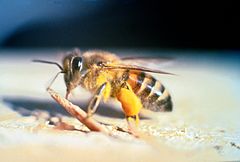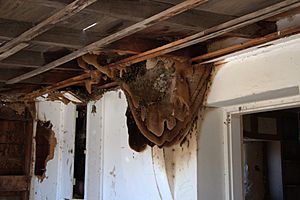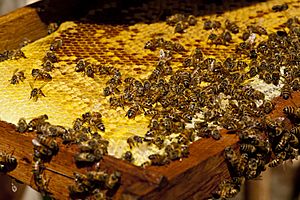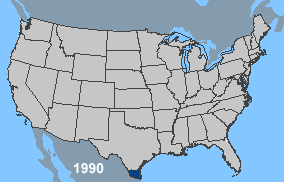Africanized honeybee facts for kids
Quick facts for kids Africanized honey bee |
|
|---|---|
 |
|
| Scientific classification | |
| Kingdom: | |
| Phylum: | |
| Class: | |
| Order: | |
| Suborder: | |
| Subfamily: |
Apinae
|
| Tribe: | |
| Genus: | |
| Species | |
|
HYBRID (see text) |
|
Africanized honeybees are a special kind of hybrid bee. They are a mix of European honeybees and African bees. Some people call them 'killer bees' because they are more protective of their homes than regular honeybees. This means they can be more dangerous if they feel threatened.
These bees got their start by accident in 1957 in Southern Brazil. A scientist named Warwick Estevam Kerr was trying to create bees that could live better in tropical places. He was mixing European honeybees with bees from southern Africa. Twenty-six Tanzanian queen bees escaped from his hives. These queens started new colonies, and their offspring became the Africanized honeybees we know today.
Contents
What Makes Africanized Honey Bees Special?
Africanized bees are known for being very protective of their hives. They will attack anything they see as a threat, including people. Over the years, many people in the Americas have been stung by these bees. Sometimes, many stings can even cause death. This strong defense is why they earned the nickname "killer bees."
Here are some things that make Africanized honey bees different:
- They often form new swarms and move to new places.
- They are more likely to leave their hive if food becomes scarce.
- Even when resting in a swarm, they are very protective.
- They often build their homes in holes in the ground, unlike European bees.
- They guard their hive very strongly. They have a larger "alarm zone" around their home.
- Their hives have many "soldier" bees ready to defend.
- They can quickly call more bees from the hive to help defend.
- They will chase and sting threats in much larger numbers and for longer distances.
Where Do Africanized Honey Bees Live?
By 2002, Africanized honeybees had spread a lot. They moved from Brazil south into northern Argentina. They also went north through South and Central America, México, Texas, Arizona, New Mexico, and southern California. For a while, they seemed to stop spreading at eastern Texas. This might have been because there were many European beekeepers there.
However, these bees have now been found in southern Louisiana. This means they might have gotten past that area. They could have also arrived by riding on a ship. In 2005, Africanized bees were found in six counties in Florida. It seems they had been there for a while without anyone knowing.
How to Stay Safe Around Bees

It's good to know how to avoid bees, especially Africanized ones. Here are some tips:
- Be careful with loud machines: Bees can feel low vibrations. A lawn mower might make a hive or swarm feel threatened.
- Watch where you walk: Try not to walk barefoot on lawns with blooming clover. Bees love clover for food.
- Avoid strong smells: Bees are attracted to flower smells. So, try not to wear strong perfumes, colognes, or scented lotions. A bee looking for flowers won't hurt you unless you swat at it.
- Look out for warning bees: Some bees patrol around their hive. They might "head butt" you if you get too close. This is a warning! If a bee bumps you, slowly walk away from the hive. Going closer could lead to more bees attacking.
- Wear light colors: Bees react to dark colors. Beekeepers wear white or light suits during the day to avoid attracting bees. When you are in areas with bees, wear light colors. Bees are not active at night, so you are less likely to meet them then.
Learn More
Images for kids
-
Africanized honey bees gathering pollen at an Engelmann's prickly pear in the Mojave Desert.
-
An African honey bee extracts nectar from a flower in Tanzania. This is a purebred African honey bee, not an 'Africanized' hybrid.
See also
 In Spanish: Abeja africanizada para niños
In Spanish: Abeja africanizada para niños







